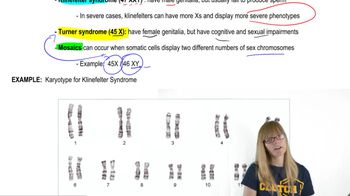Table of contents
- 1. Introduction to Genetics51m
- 2. Mendel's Laws of Inheritance3h 37m
- 3. Extensions to Mendelian Inheritance2h 41m
- 4. Genetic Mapping and Linkage2h 28m
- 5. Genetics of Bacteria and Viruses1h 21m
- 6. Chromosomal Variation1h 48m
- 7. DNA and Chromosome Structure56m
- 8. DNA Replication1h 10m
- 9. Mitosis and Meiosis1h 34m
- 10. Transcription1h 0m
- 11. Translation58m
- 12. Gene Regulation in Prokaryotes1h 19m
- 13. Gene Regulation in Eukaryotes44m
- 14. Genetic Control of Development44m
- 15. Genomes and Genomics1h 50m
- 16. Transposable Elements47m
- 17. Mutation, Repair, and Recombination1h 6m
- 18. Molecular Genetic Tools19m
- 19. Cancer Genetics29m
- 20. Quantitative Genetics1h 26m
- 21. Population Genetics50m
- 22. Evolutionary Genetics29m
3. Extensions to Mendelian Inheritance
Sex Chromosome
Problem 29c
Textbook Question
In chickens, a key gene involved in sex determination has recently been identified. Called DMRT1, it is located on the Z chromosome and is absent on the W chromosome. Like SRY in humans, it is male determining. Unlike SRY in humans, however, female chickens (ZW) have a single copy while males (ZZ) have two copies of the gene. Nevertheless, it is transcribed only in the developing testis. Working in the laboratory of Andrew Sinclair (a co-discoverer of the human SRY gene), Craig Smith and colleagues were able to 'knock down' expression of DMRT1 in ZZ embryos using RNA interference techniques (see Chapter 18). In such cases, the developing gonads look more like ovaries than testes [Nature 461: 267 (2009)]. What conclusions can you draw about the role that the DMRT1 gene plays in chickens in contrast to the role the SRY gene plays in humans?
 Verified step by step guidance
Verified step by step guidance1
Identify the role of the DMRT1 gene in chickens: It is located on the Z chromosome and is male-determining, similar to the SRY gene in humans.
Understand the genetic difference between male and female chickens: Males are ZZ and have two copies of DMRT1, while females are ZW and have one copy.
Note the experimental approach: Researchers used RNA interference to 'knock down' DMRT1 expression in ZZ embryos, leading to gonads resembling ovaries.
Compare with the SRY gene in humans: SRY is located on the Y chromosome and is crucial for male development, while DMRT1 is on the Z chromosome and requires two copies for male development in chickens.
Conclude the role of DMRT1: It is essential for male development in chickens, and its absence or reduced expression in ZZ embryos can lead to the development of female characteristics, highlighting its critical role in sex determination.
Recommended similar problem, with video answer:
 Verified Solution
Verified SolutionThis video solution was recommended by our tutors as helpful for the problem above
Video duration:
3mPlay a video:
Was this helpful?
Key Concepts
Here are the essential concepts you must grasp in order to answer the question correctly.
Sex Determination Genes
Sex determination genes are critical in establishing the sexual phenotype of an organism. In chickens, the DMRT1 gene on the Z chromosome is essential for male development, similar to the SRY gene in humans. However, the mechanisms differ; DMRT1 is present in males with two copies and is only expressed in the developing testis, while SRY is a single gene that triggers male development in humans.
Recommended video:
Guided course

Sex Determination
Chromosomal Differences in Sex Determination
Chickens exhibit a ZW sex-determination system, where males are ZZ and females are ZW. This contrasts with the XY system in humans, where males are XY and females are XX. The presence of DMRT1 on the Z chromosome and its absence on the W chromosome highlights the chromosomal basis of sex determination in chickens, influencing the expression of sex-specific traits.
Recommended video:
Guided course

Sex Determination
RNA Interference Techniques
RNA interference (RNAi) is a biological process where RNA molecules inhibit gene expression, effectively 'knocking down' specific genes. In the context of the DMRT1 gene, researchers used RNAi to reduce its expression in ZZ embryos, leading to the development of gonads resembling ovaries. This technique is crucial for studying gene function and understanding the roles of specific genes in development.
Recommended video:
Guided course

RNA Interference

 4:24m
4:24mWatch next
Master Sex Determination with a bite sized video explanation from Kylia Goodner
Start learningRelated Videos
Related Practice


